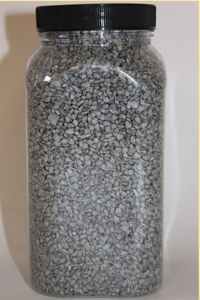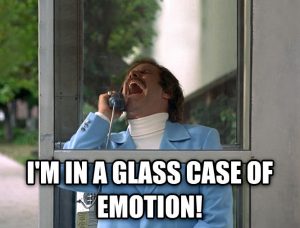Big Rocks, Small Vessels, and Programming Balance
A few years ago I heard a great story about where we spend our time and energy.
The cool thing is this story can give some significant parallels to training program design, and how you spend your energy, and whether you should work on different characteristics of training.

Big rocks could represent higher threshold strength or explosive power elements, such as max squats, deadlifts, sprints, olympic lifting, etc. You’re going to be limited to how much of this you can do at any ability, even if you are a healthy and highly active individual. Most olympic sprinters don’t train at full gas all year, and likely only do a few sessions close to their absolute highest end of performance. The same goes for established powerlifters and olympic lifters.
The medium sized rocks could represent lower threshold activities, done to produce some level of hypertrophy or endurance. They could also represent more mid-tempo cardio training if you’re into cycling or running. You can do a large volume of this stuff without getting into any state of disrepair compared to the higher threshold big rocks.

The smallest grains of sand can include drills or skill work that can be done nearly constantly. In the gym, this could go for foam rolling, low intensity mobility work, and “groove reps” with next to no weight but working on dialing in positioning and technique. These typically don’t stress the individual very much, so you could do hundreds of reps of these compared to single reps of any of the higher threshold work.

Another important consideration for this analogy is the size of the vessel itself. A small test tube could hold a lot of sand, but no big rocks. A gigantic hipster-style mason jar can hold a bunch of big rocks and likely almost endless amounts of low threshold stuff, even though it may not be enough to challenge the person.
The size of the vessel could be indicative of the individuals training experience, work capacity, and threshold for positive adaptation. Those with a bigger vessel will require more “stuff” to see forward progress, which is why you see a lot of rather elite athletes putting in countless hours of training each week, with enough big rocks to see progress.
For de-trained, elderly, or injured individuals, the size of their vessel is considerably smaller than a healthy, young athlete, so their ability to work in more volume, and especially more high threshold big rocks, is going to be somewhat limited in comparison.
What this means is that while a younger athlete could realistically train with higher threshold activities on a near daily basis, and just sprinkle in the lower threshold stuff as they see fit, someone who has a smaller vessel would likely only manage to use a higher threshold strategy on an occasional basis, or may need to rely almost entirely on low or moderate threshold activities to train safely. This isn’t to say that they couldn’t use higher threshold stuff, but their limits are significantly lower than a healthy athlete, and their relative recovery from such activities may be a lot higher.

So how can you know whether to use a higher threshold skillset or requirement? A lot of that comes to the individuals training history and age, plus history of injuries. If someone has been training for a while, usually more than 2-5 years, they could realistically say they’ve seen physiologic adaptations to help them tolerate higher threshold stuff.
For older clients, their rate of recovery from very stressful training is much slower than someone younger, even if they’re incredibly fit. They may still be able to use higher threshold work, but might need more time between those higher threshold sessions. If you’ve had an injury, your ability to tolerate repeated higher threshold sessions will be reduced as well, so you might need more moderate or low threshold work in your programming, but again, everyone is different.
I like the outlining of volume considerations by Renaissance Periodization, and when Mike Israetel came to Edmonton to discuss hypertrophy as part of the L2 Fitness Summit (click the link to get the videos) he outlined the concepts of minimal effective dose and maximum recoverable volume.
Minimum Effective Dose is the smallest training volume or intensity required to see positive adaptation. More than that produces more of a positive adaptation, up to your Maximum Recoverable Volume. Beyond that point, you start pushing into overtraining and improper recovery.
For example, a well-trained Olympic lifter may require 30 sets of triples level or higher intensity to see their strength improve in a given week, but would begin a slow death if that number got over 50 sets at the same intensity. A beginner may only be able to tolerate 10 sets of this relative intensity due to not having adapted to the volume as effectively as a more seasoned lifter.
Likewise, the Mr. Olympia hypertrophy program you see in the magazines may involve about 25 sets per bodypart per week with rep ranges between 8-12 and pushing loading close to if not at failure for many or all of them. A less experienced lifter may require using a smaller intensity and consder leaving 2-3 “reps in reserve” (another term from Mike) versus pushing right to failure on each set in order to survive this amount of volume. That, or they push close to failure on something more like 10 sets, and do the others as lower intensity work.
If you have a well developed aerobic system, you can have expedited oxygen replenishment into the working muscles and faster removal of waste products, which helps to expand your work capacity, essentially giving you a bigger vessel for your training rocks. De-conditioned individuals, even if strong, will have a smaller training volume available to them due to less ability to recover from the intensity they’re able to work with.
So how can you decide how much volume you can tolerate at a given intensity? Well, the best way is to track stuff. Do a workout you would normally do, then the following week add a set or three and see how you feel. If you have some gentle soreness but can still function relatively well, add some more volume the following week and see what you feel like. If you notice you can still maintain your strength and general output throughout the sets and recover relatively well, keep adding volume until you get to a point where your output suffers.
Charlie Francis, a track coach from back in the day, used the 10% rule, whereas he would have his athletes do repeats of a certain distance, and once their times dropped by 10% from their top set, the workout was done. Using this guide, if you squat 300 pounds for 5 reps, that’s 1500 total pounds of volume. Still using 300 pounds, if you get to a point where you can only successfully grind out 4 reps in a set, you’re done. It’s more than a 10% drop in output. If you use something to track bar speed, that would be an even better metric, as you would see your specific velocity decrease from one rep to another, or from one set average to another.
Continue adding volume to a point where you see a 10% or greater drop off in output, and then train to that volume. This can give an idea of how much work capacity you can tolerate at that specific intensity.
Following this, you could do a track of your resting heart rate the morning following such intense workouts. If your resting heart rate is barely any higher, you’re likely handling that training stress pretty effectively. If you want to dig deeper than resting heart rate, you can look into Heart Rate Reserve measurements and devices.
If your resting heart rate is elevated, you’re still trying to process that training session. If it stays up for more than a couple of days, it was a big stressor to you, so it might be more of an occasional workout versus a every Wednesday kind of session.
Muscle soreness following a novel workout or training stress can also be a potential “metric” to seeing how well you handle a specific intensity or challenge. After a new workout of any kind, you should be a bit sore if it was a novel challenge or intensity. If you repeat the activity and intensity a few times, that soreness should reduce significantly to the point where you might not be sore from the same thing anymore. If you’re always sore from a specific workout or intensity, you’re either taking too long between those workouts, not enough time between them, or working with a volume or intensity outside of your ability to adequately recover. Normally, if you repeat a given workout after 5-8 days, it shouldn’t make you as sore as the first time.
Now the great thing about training is you can expand a lot of things in this example. The size of your vessel increases as you increase your work capacity and ability to handle higher levels of training stress. The size of the rocks you can manage increases as the absolute and relative strength improvements occur, and you can fit in more training volume overall. So it could be said that a major goal of training is to simply have a larger container in which to fit all your training stressors. That may not sound as sexy as “look hot naked,” but it does a lot more.
One Response to Big Rocks, Small Vessels, and Programming Balance